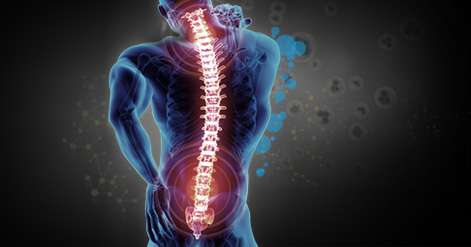Back Pain

Back pain or backache is the pain felt in the back that may originate from muscles, nerves, bones, joints or other structures in the spine. Back pain is one of the most common medical problems experienced by most people at some time in their life. Back pain can be acute usually lasting from a few days to a few weeks, or chronic pain, lasting for more than three months.
Back pain can occur as a dull constant pain or a sudden sharp pain. Back pain may be confined to one area or may radiate to other areas such as the arm and hand, the upper back, or the lower back, and might radiate into the leg or foot. Other than pain you may have weakness, numbness or tingling in your arms or legs caused from damage to the spinal cord.
Athletes participating in sports such as skiing, basketball, football, ice skating, soccer, running, golf or tennis are at greater risk of developing back pain. During these sport activities, the spine needs to bear more stress, take up more pressure, undergo twisting and turning, as well as bodily impact. This may cause strain on the back that can result in back pain. Athletes are at high risk of back pain both from trauma and from overuse injuries, especially in sports requiring hyperextension.
Common causes of back pain in athletes include:
- Musculoligamentous strain : It is the most common sports injury caused by injury to the soft tissues around the spine
- Spondylolysis : It is most commonly found in athletes who participate in sports such as gymnastics, pole-vaulting, and football. All these activities require frequent hyperextension of the lumbar spine
- Spondylolisthesis: It is a condition of the spine which occurs when one vertebra is displaced or has slipped forward over the other below it
- Herniated nucleus pulposus : When injury occurs, the central core of the disc is pushed through a tear in the outer hard layer of the disc, causing a bulge and pressing on nearby nerves. If the herniated disc presses on a spinal nerve, it can cause back pain.
Other causes include growth-related problems such as scoliosis and Scheuermann's kyphosis.
Your physician will diagnose back pain by asking appropriate questions or by taking a history of your problem and examining your spine. A complete examination includes examination of the signs of unusual curves of the spine, a rib hump, a tilted pelvis, and tilting of the shoulders and a test of your sensations. Other diagnostic tests may be needed to confirm the diagnosis.
Treatment for back pain is usually non-surgical and includes:
- Anti-inflammatory medications, or NSAIDs are recommended to provide relief from pain.
- Cold packs, heat packs or both, applied to the back will help to ease much of the discomfort and relieve stiffness as well the pain.
- Sleeping with the pillow between the knees while lying on one side or placing the pillow under your knees when lying on your back may help relieve back pain.
- Exercises to strengthen your trunk and back muscles.
These measures help to relieve your back pain, however, in certain conditions the pain may not be resolved and may require surgical treatment. Your physician will decide on the appropriate surgery based on several factors.

